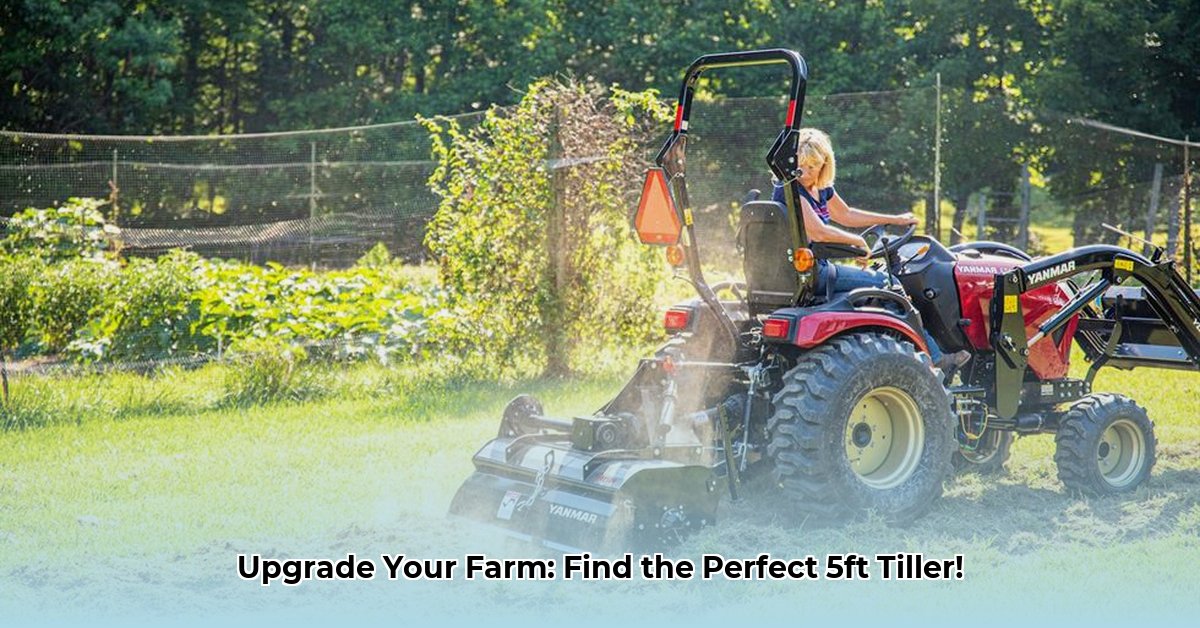
Choosing the right 5-foot tiller can significantly impact your farm's efficiency and sustainability. This guide compares two popular options—the Rural King RT5 and a Countyline tiller—to help you make an informed decision. We'll explore their features, performance, and long-term costs, emphasizing sustainable farming practices. For more tractor attachment options, check out this helpful resource.
Understanding 5ft Rotary Tillers and Their Importance
Five-foot rotary tillers are versatile implements ideal for smaller to mid-sized farms. They attach to your tractor's PTO (Power Take-Off shaft – the part of the tractor that transmits power from the engine to the implements) and use rotating tines to break up soil, creating a seedbed for planting. The choice of tiller significantly affects soil health, fuel efficiency, and overall farm productivity. Are you ready to optimize your soil preparation and increase your farm's bottom line?
Rural King RT5 vs. Countyline Tiller: A Detailed Comparison
Direct comparison requires specific Countyline model details, however, we can evaluate key factors affecting performance and sustainability. This comparison prioritizes fuel efficiency and long-term cost, crucial elements for sustainable farming.
| Feature | Rural King RT5 | Countyline Tiller (Specific Model Needed for Precise Comparison) | Considerations |
|---|---|---|---|
| Horsepower Requirement | 25-40 HP (depending on soil conditions) | Varies; consult manufacturer specifications | Higher horsepower often correlates with higher fuel consumption, but may be necessary for heavy soils. |
| Tine Material | Hardened steel | Typically hardened steel (verify specifications) | Hardened steel is durable but the quality varies. Higher quality equates to longer lifespan. |
| Gearbox Material | Cast iron (often) | Varies; consult manufacturer specifications | Cast iron gearboxes are generally robust but can be heavier, increasing fuel consumption. |
| Price | Typically more affordable | Varies greatly depending on the model and retailer | Initial cost is only one factor; consider maintenance and operating costs over the tiller's lifetime. |
| Maintenance Needs | Regular lubrication, tine inspection, gearbox maintenance | Similar: regular maintenance is vital for all tillers | Planned maintenance prevents costly repairs and extends the life of your tiller. |
| Estimated Fuel Consumption | Higher due to higher horsepower requirements | Difficult to quantify precisely without operational data | Higher horsepower demands more fuel. Consider fuel efficiency alongside tilling performance. |
| Soil Suitability | Adaptable; performance varies with soil type | Varies; consult manufacturer specifications | Choose a tiller weight and horsepower suited to your soil conditions. |
Choosing Your Ideal 5ft Tiller: A Step-by-Step Guide
Selecting the right tiller involves careful planning. Follow these steps:
- Assess Your Soil: Identify your soil type (clay, sandy loam, etc.). This dictates the required tiller power.
- Measure Your Land: Determine the acreage you need to till to ascertain appropriate tiller size.
- Check Tractor Compatibility: Ensure your tractor has sufficient PTO horsepower (consult your tractor's manual).
- Define Your Budget: Consider the initial purchase price, maintenance, and potential replacement costs.
- Compare Tillers: Evaluate features, comparing the options available in your area.
- Prioritize Long-Term Value: A high-quality tiller, while pricier initially, may offer longer service life and lower ongoing costs.
Maintenance and Operation: Extending the Life of Your Tiller
Regular maintenance is crucial for optimal performance and extending the lifespan of your tiller. Follow these guidelines:
- Pre-Operation Inspection: Always check tines, gearbox, PTO shaft, and hitch before each use.
- Regular Lubrication: Use the manufacturer's recommended lubricants and follow their schedules.
- Post-Operation Cleaning: Remove debris immediately after tilling.
- Safety Precautions: Always wear safety gear (gloves, eye protection) when operating the tiller.
Sustainable Farming Practices and Tiller Selection
Efficient tilling practices are vital for sustainable agriculture. Consider these strategies:
- Reduced Tillage: Explore reduced tillage techniques (no-till, strip-till) to enhance soil health and reduce fuel consumption.
- Soil Health: Prioritize soil health through practices that minimize soil disturbance and improve organic matter content.
- Fuel Efficiency: Select a tiller with sufficient power but that minimizes unnecessary fuel consumption.
Conclusion: Making the Right Choice for a Sustainable Future
Choosing the right 5-foot tiller is a significant decision that impacts both efficiency and sustainability. By carefully considering your individual needs and following this guide's recommendations, you can select a tiller that optimizes your farm's productivity while respecting the environment and your budget. Remember to consult manufacturer specifications and local agricultural experts for further guidance.